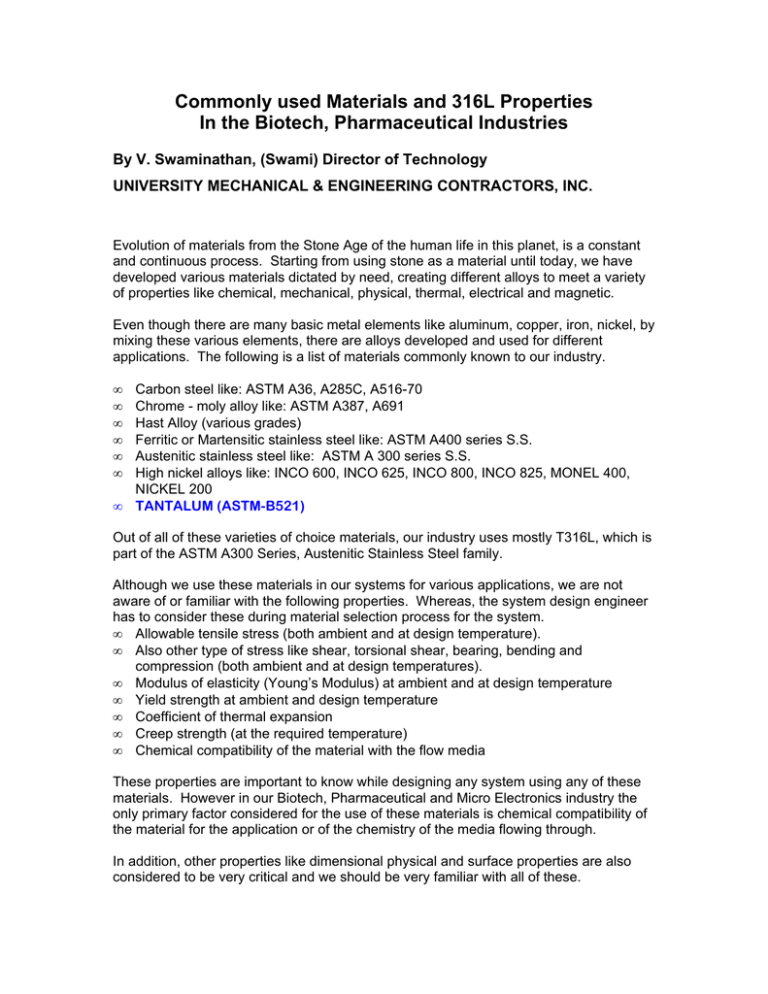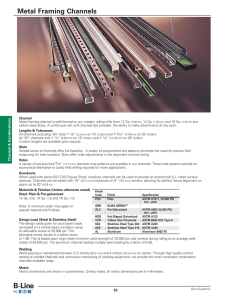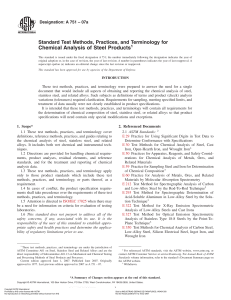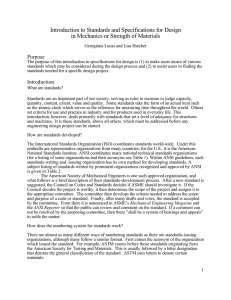Commonly used Materials and 316L Properties In the Biotech, Pharmaceutical Industries
advertisement

Commonly used Materials and 316L Properties In the Biotech, Pharmaceutical Industries By V. Swaminathan, (Swami) Director of Technology UNIVERSITY MECHANICAL & ENGINEERING CONTRACTORS, INC. Evolution of materials from the Stone Age of the human life in this planet, is a constant and continuous process. Starting from using stone as a material until today, we have developed various materials dictated by need, creating different alloys to meet a variety of properties like chemical, mechanical, physical, thermal, electrical and magnetic. Even though there are many basic metal elements like aluminum, copper, iron, nickel, by mixing these various elements, there are alloys developed and used for different applications. The following is a list of materials commonly known to our industry. • • • • • • • Carbon steel like: ASTM A36, A285C, A516-70 Chrome - moly alloy like: ASTM A387, A691 Hast Alloy (various grades) Ferritic or Martensitic stainless steel like: ASTM A400 series S.S. Austenitic stainless steel like: ASTM A 300 series S.S. High nickel alloys like: INCO 600, INCO 625, INCO 800, INCO 825, MONEL 400, NICKEL 200 TANTALUM (ASTM-B521) Out of all of these varieties of choice materials, our industry uses mostly T316L, which is part of the ASTM A300 Series, Austenitic Stainless Steel family. Although we use these materials in our systems for various applications, we are not aware of or familiar with the following properties. Whereas, the system design engineer has to consider these during material selection process for the system. • Allowable tensile stress (both ambient and at design temperature). • Also other type of stress like shear, torsional shear, bearing, bending and compression (both ambient and at design temperatures). • Modulus of elasticity (Young’s Modulus) at ambient and at design temperature • Yield strength at ambient and design temperature • Coefficient of thermal expansion • Creep strength (at the required temperature) • Chemical compatibility of the material with the flow media These properties are important to know while designing any system using any of these materials. However in our Biotech, Pharmaceutical and Micro Electronics industry the only primary factor considered for the use of these materials is chemical compatibility of the material for the application or of the chemistry of the media flowing through. In addition, other properties like dimensional physical and surface properties are also considered to be very critical and we should be very familiar with all of these. TABLE I Quick reference table for the percentage of chemical composition of T316L grade, various ASTM designated tubing: Material Element Carbon (max) Manganese (max) Phosphorus (max) Sulfur (max) Silicon Nickel Chromium Molybdenum A213 0.035 A249 0.035 2.00 2.00 0.040 ASTM A269 0.035 A270 0.035 A511 0.035 A632 0.040@ 2.00 2.00 2.00 2.00 0.040 0.040 0.040 0.040 0.040 0.030* 0.030* 0.030* 0.030* 0.030* 0.030* 0.750 10 to 15 16 to 18 2 to 3 0.750 10 to 15 16 to 18 2 to 3 0.750 10 to 15 16 to 18 2 to 3 0.750 10 to 15 16 to 18 2 to 3 1.00@ 10 to 15 16 to 18 2 to 3 0.750 10 to 15 16 to 18 2 to 3 Note: All of the above values are in percentages. * Even though the ASTM specification permitted value shall be 0.030 maximum, for achieving good weld we limit the Sulfur content to be 0.005 to 0.017. @ This value is different than others. Commonly used 316L STAINLESS STEEL TUBING Diameter (In) 0.125 0.250 0.375 0.500 0.750 1.000 1.500 2.000 3.000 4.000 Wall (In) 0.020 0.035 0.035 0.049 0.065 0.065 0.065 0.065 0.065 0.083 Length (ft) 10 20 20 20 20 20 20 20 20 20 Dimensional/Physical Properties Permitted/Variations/Tolerances: Wall Thickness: Circularity/Ovality : (out of roundness) +/- 10% + 1/64” / - 1/32” or 2% of O.D. (max) or +/- 0.01” whichever is smallest Straightness/Cylindricity = Length (up to 24ft. long): 0.01” per ft. Under 2” Ø = + 1/8” / -0 2” Ø and over = + 3/16” / -0 All of the above are per the ASTM standards. Surface Finish: This requirement is special and implemented by our industry. ID (Surface with media/product contact) = 15 Ra or better and EP. OD = 30 Ra or better. Note: Identifying the surface finish by the grit size is not the proper way. Advantages of Electro polishing • Corrosion resistance is maximized by electro polishing because the surface is equipotentialized - galvanic differences resulting from stress are removed. • Surface passivation is maximized by electro polishing because the surface contains very low levels of Fe in zero oxidation states. • Surface contaminants are minimized because electro polising removes them. • Surface smoothness is maximized because electro polishing has a leveling action and can improve surface smoothness by up to 50% as measured by a surfanalyzer using ANSI B46.1 standard. SUMMARY / CONCLUSION The above attempt is to highlight the history of development of various materials, with emphasis on T316L tubing and its minimum, but not necessarily all requirements. I would like to conclude with a question, which would be, “Is T316L the only material available for our use or is there any better material?” Swami




